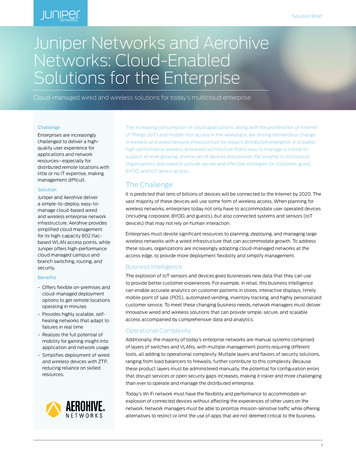
Transcription
Expanding the networks ofdisadvantaged entrepreneursSarah Drakopoulou Dodd and Janroj KelesA background paper for the OECD Centre forEntrepreneurship, SMEs and Local Development
TABLE OF CONTENTS1. INTRODUCTION AND OVERVIEW . 42. NETWORKING AND ENTREPRENEURSHIP. 52.1. Outcomes . 52.2. Structural Issues . 72.3. Process . 92.4. Context and Contingencies . 103. ENTREPRENEURIAL NETWORKS AND DISADVANTAGED GROUPS . 143.1. Women. 143.2. Ethnic Minorities . 163.3. Migrants . 173.4. Disabled People . 183.5. Age-related Disadvantage . 193.6. Long-Term Unemployed . 214. EU POLICY APPROACHES TO NETWORKING AND SUPPORTING DISADVANTAGEDENTREPRENEURS. 244.1. Introduction. 244.2. Cross national and national schemes and networks for the generation 50 . 254.3. Networking women entrepreneurs . 304.4. The European Network on Ethnic Minority Business . 334.5. Networking young entrepreneurs. 344.6. Networking people with disabilities . 354.7. Networking the othernized entrepreneurs and the question of digital divide . 364.8. Good Practices . 375. CONCLUDING REMARKS . 39REFERENCES . 392
APPENDIX. METHODOLOGY AND SOURCES. 46TablesTable 1. Social networks throughout entrepreneurial stages . 4Table 2. Networking outcomes and entrepreneurial benefits . 6Table 3. Entrepreneurial networks and policy implications . 13Table 4. Labour market deficiencies and disability . 19Table 5. Entrepreneurial networks, disadvantaged groups and policy implications . 23Table 6. Cross-national and national schemes and networks for the generation 50 . 29Table 7. Good practices of networking across the EU. 37Table 8. The bundesweite gründerinnenagentur (BGA) (in English: National Agency for WomenStart-ups Activities and Services) . 38FiguresFigure 1. International patterns of entrepreneurial networking . 11Figure 2. Entrepreneurship and gender . 15Figure 3. Age and entrepreneurship. 213
1. INTRODUCTION AND OVERVIEWSocial networks impact profoundly on the early stage entrepreneurial process, from theacquisition of motivation, through opportunity perception, idea validation, the identification ofresources, negotiations to get into business, and the subsequent birth and survival of the firm. Table 1illustrates this argument, demonstrating that, for nascent and potential entrepreneurs, the socialnetwork is a paramount context within which entrepreneurship is enacted. Given this, it becomeshighly relevant to consider how, if entrepreneurship is to be given serious credence as a policyobjective, such networks can be usefully deployed to strengthen the quantity and quality ofenterprising action.Table 1. Social networks throughout entrepreneurial stagesStageImpact of Social NetworksExamplesAcquiringmotivationThe nature and intensity of entrepreneurialmotivation is strongly shaped by the norms ofthe local environment, experienced throughentrepreneurs’ interactions with ty, of entrepreneurial career paths areboth learnt by potential and nascententrepreneurs, through their social networksFamily influence, especially parentalentrepreneurship,shapesmotivationstrongly. So, too, does a selection of stronglocal role models. Even specific ethnic andreligious traditions of enterprise can be veryimportant network-driven motivators.OpportunityPerceptionPersonalized information forms the basis ofmost successful new venture ideas, and this isa function of ties developed through personal,educational and professional experience.Growing entrepreneurs’ ideas for newproducts emerge through market discussionswith strong tie contacts, often customers.Validating theideaEarly testing of the opportunity idea typicallytakes the form of discussion with potentiallyimportant others already known to theentrepreneur.For serial entrepreneurs, moving from ideato concept involves dialogue with a tightcircle of strong ties, with the same ties beingutilised for a variety of new ventures overthe entrepreneur’s careerIdentifyingresourcesSearching for resources, and matching them tothe needs of the planned new venture, happensthrough personal interactions between theentrepreneur and their contacts, who may alsobroker links to resource holders.For first time entrepreneurs especially,securing start-up resources is very oftenfeasible only through trusted strong tiecontacts, including family, friends, and closebusiness colleagues.Negotiating toget intobusinessSecuring resources, customers, employees,suppliers and distributors demands thatnascent entrepreneurs build exchangerelationships with other individuals, and theirorganizations.Evidence shows how important previousprofessional contacts are to winning earlyorders for the new venture.Birth andSurvivalLaunching the venture requires thatentrepreneurs move from planning withothers, to acting with them.Survival and growth are dependent on newideas, new resources, new alliances – and allof these are network-mediated.Source: The entrepreneurial stage model presented here is drawn from Gibb and Ritchie (1982), and summarizesarguments made in Drakopoulou Dodd et al (2004).4
This report aims to consider how networking might be used to enhance the entrepreneurialsuccess of disadvantaged groups. It begins by setting out the core rationale for this aim, namely, thepositive outcomes which have been associated with entrepreneurial networking. The main elements ofimportance to entrepreneurial networking – structure, context, process – are also explained, beforebeing applied to consideration of a variety of disadvantaged groups. Next, extant policy interventionsare presented and analyzed. Each section of the report closes with specific recommendations as tofuture good practice, which are briefly revisited in the concluding comments.2. NETWORKING AND ENTREPRENEURSHIPThis section provides definitions, descriptions and analysis of the core concepts used to thinkabout, and work with, entrepreneurial networks. Specifically, it addresses the outcomes, structure,processes and contingencies associated with entrepreneurial networks.2.1. OutcomesWhy do networks, and networking, so matter to entrepreneurs? What is it about these phenomenathat has elevated them in the priorities of entrepreneurship scholars and policy makers? The simpleanswer is that, since the early days of studying this topic, in the mid 1990s, it rapidly became clear thatvery many desirable core entrepreneurship outcomes were strongly facilitated by strong networkingprocesses, and network structures. Far from being an isolated (heroic) individual, entrepreneurs gainmultiple benefits from warm and trusting interaction with a range of other people. Taken together,these outcomes were found to be highly influential in supporting venture survival 1 and success 2(variously measured as revenue growth and employment growth). Table Two summarizes positiveoutcomes which have been found to emanate from networking processes, and the entrepreneurialbenefits thereby accrued, which include expansion of the entrepreneur’s latent resource base, theprovision of resources on favourable terms, as a source of venture-specific knowledge, as a site forentrepreneurial learning and knowledge-sharing, and a frame for the generation of reputation andlegitimacy.Disadvantaged entrepreneurs typically lack access to some or all of these positive networkingoutcomes, due to the paucity of resources at their disposal, including financial, social and humancapital. It is thus no great surprise that policy makers, at local and national level, have long looked tonetwork development as a mechanism for enhancing the entrepreneurial potential of thedisadvantaged. However, networking outcomes are themselves dependent, as has become increasinglyclear, on the structure, processes, content and context of (entrepreneurial) networks.12See, for example, Arocena, 1984; Brüderl and Preisendörfer, 1998; Huggins, 2000; Szarka, 1990,As demonstrated by Brüderl and Preisendörfer, 1998; Hansen, 1995; Jack and Anderson, 2002; Johannisson,1986; 1987; Johannisson and Nilsson, 1989; Johannisson and Peterson, 1984; Ostgaard and Birley,1994.5
Table 2. Networking outcomes and entrepreneurial benefitsNetworking OutcomeExpands the latent resource base ofthe entrepreneur, which includes“brokering” connections topotentially important others.Entrepreneurial BenefitsOpens up a wider range ofopportunities, by facilitatingaccess to a more diverse andextensive pool of “collective”resources.Relevant StudiesAldrich and Zimmer, 1986; Birley,1985; Carsrud and Johnson, 1989;Johannisson et al, 1994; Shaw, 2006;Jack et al, 2010, Burt, 1992, Jack,2005Bridges “structural holes” in theentrepreneur’s own network ofdirect contacts, by offeringaccess to new and prelegitimized relationships.Provides resources, includingfinancing, and trustworthyemployees, on amicable and rapidlyagreed terms.Smooths and accelerates thetrajectory from nascententrepreneurship to start-up, andsubsequently venture growth.Enhances fit between ventureand (human) resourcesDrakopoulou Dodd, 2012, Ostgaardand Birley, 1994, Uzzi and Gillespie2002 p613, Shane and Cable, 2002, p377; Brüderl and Preisendörfer,1998; Jack, 2005Acts as a source of, and conduit for,private, specific, timely commercialinformationProvides a (well-motivated andfocused) early warning systemfor both threats andopportunitiesBurt, 1992, Hills, Lumpkin andSingh, 1997, Uzzi, 1997, de Koning,1999Entrepreneurial learning, sharing ofknowledge and expertise, clusteredknowledge interactions, provision ofsupport and adviceExtends and deepens humancapital, both for entrepreneurs,and for the local “eco-system”.Karatas-Ozkan, 2011; Karatas-Ozkanand Chell, 2010; De Propis, 2000;Uzzi, 1997; Johannisson, 1996, 1997,Can lead to the generation ofmeso-level innovation systems,and co-enactment ofopportunities.Offsets the “loneliess” andisolation of the entrepreneurNetworks provide a structure, andprocesses, through which anentrepreneur can build credibility andtrust for themselves and the newventure.Nascent and early stageentrepreneurs lack market place“clout”, because they are newand small. Network-based trustallows them to punch abovetheir weight, thanks to thecredibility which their networkcontacts award them.6Jack, 2005, Shane and Cable, 2002
Networking structure comprises the web of inter-relationships which connect people to eachother, and the nature of the ties that bind them together. Networking processes are what people do,together, through these ties, which includes sharing information and resources, negotiating agreementsand alliances, dialoguing about ideas, visions and plans, co-creating new knowledge, linking people toeach other, and building friendships. Network content relates to what is built or exchanged throughnetwork processes: information, resources, knowledge, and emotions. Network contexts are the socioeconomic settings within which relational matrices are embedded, and which they also enact, and canbe considered in a variety of ways, including national comparisons, specific local settings, industrialsectors, and regional clusters.Therefore, to exploit the potential benef
outcomes, due to the paucity of resources at their disposal, including financial, social and human capital. It is thus no great surprise that policy makers, at local and national level, have long looked to network development as a mechanism for enhancing the entrepreneurial potential of the disadvantaged. However, networking outcomes are .











